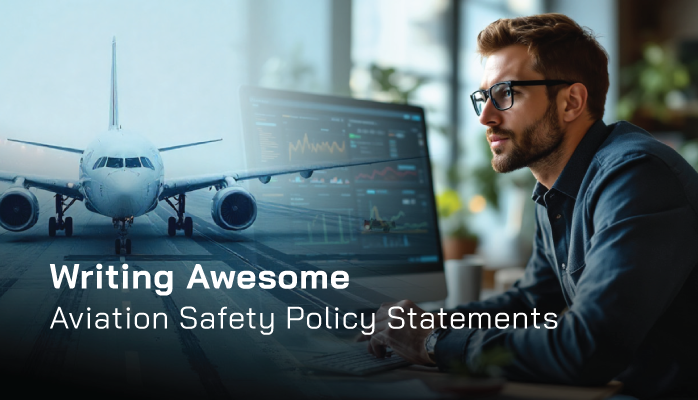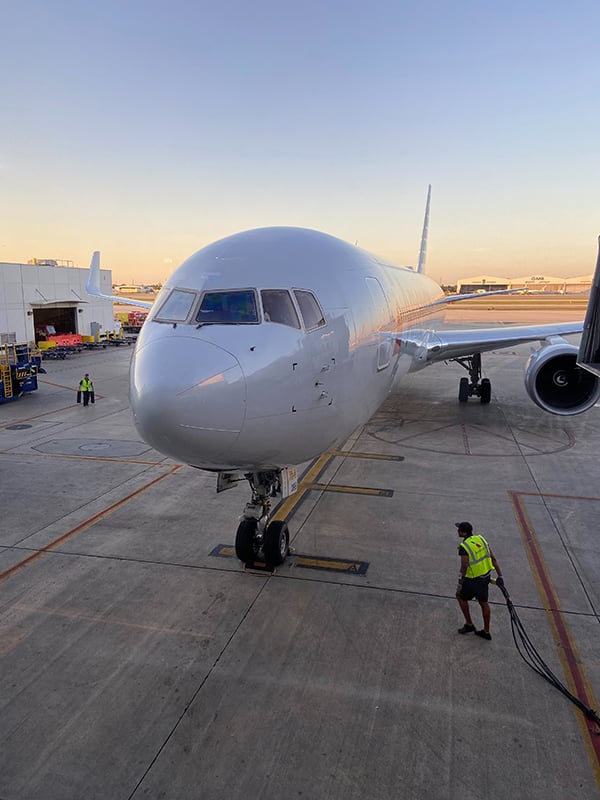Safety Policy Is the Architecture of Aviation SMS

Aviation safety management systems (SMS) are supported by the safety policy which is endorsed by the organization's accountable executive. The safety policy communicates management's commitment to the SMS while also affording employees protection from self-reporting errors or mistakes.
Aviation SMS safety policy statements are the framework around employees'
- roles,
- obligations, and
- guidance in all safety-related circumstances.
Related Articles on Aviation SMS Safety Policy
- What Should Be in Your Safety Policy in Aviation SMS
- How to Review Aviation SMS Safety Policies - Free Checklist
- Writing & Reviewing Aviation SMS Safety Policies - 4 Free Templates
A safety policy's secondary function is to act as an outlet to show the world - auditors, aviation authority, media, etc - that your company is not blatantly negligent during unexpected situations. You know the situation. The one that is on the front page of the newspaper after a major accident or an environmental mishap.
In other words, when there is an accident, it is much less likely to be viewed as an organizational failure than an isolated incident.
What Should Aviation Safety Policies Cover?

Great aviation safety policies need to address the following items both succinctly and in detail:
- Top management's commitment to safety
- Safety goals and objectives and how they are measured/monitored;
- Accountable executive's commitment to provide necessary resources for the SMS;
- Expectations of employees and management relating to SMS participation;
- Responsibilities of various roles in the SMS architecture;
- Organization's various approaches to managing safety;
- Your hazard reporting policy;
- Employee behaviors not protected by the SMS; and
In other words, it needs to cover everything (within reason) without looking like a complex civil court case analysis.
And it's tough to do in a relatively short, easy-to-read document.
This is why a typical safety policy
- usually does not adequately touch on all the areas it should,
- is hard to navigate,
- is so general as to be meaningless; or
- adds no value to the intended audience (the employees).
Before anything make sure you are clear on the who, what, and why of aviation safety policy. There is considerable guidance on writing safety policy statements. Unfortunately, the safety policy is one of the first SMS implementation tasks that safety managers usually write on behalf of the accountable executive. There is little thought regarding the effect of the safety policy on the organization's safety culture.
A hastily-written, short-sighted safety policy is a tragedy because the safety policy is the solid foundation on which gives employees the assurance that management is sincerely interested in "safety" and this is not simply another fad to keep employees "satisfied" or "feeling safe."
With that in mind, here are some tips for writing awesome safety policy statements.
Related Aviation Safety Policy Articles
- SMS First Steps - Which Safety Policy?
- 4 Pieces of Safety Policy Your Aviation SMS Should Have
- How to Know if Your Aviation Safety Policy Is Complete
Use Templates
Don't reinvent the wheel.
Templates serve several wonderful purposes:
- Already established organization and structure
- Cover areas you may have missed
- Guide for writing style
- Can demonstrate in so many ways what not to do
Aviation safety policy templates come in many forms and from many sources, such as civil aviation authorities or standards bodies, such as IS-BAO or the Flight Safety Foundation.
Templates can be
- a policy that has already been written in your organization,
- examples downloaded from the web,
- guides such as ICAO's Safety Management Manual, or
- even the public policy statements from other companies.
Using templates is also a great tool to improve the quality of policy statements that you have already written.
Should Read Almost Like a Checklist

Some of the worst policy and procedure documentation that I have ever read had nothing to do with the content. I have a specific example in mind wherein the content was comprehensive, with great use of language. But looking at it gave me a headache - I was assaulted by blocks of text.
It was obvious that the policy was not written for the end user, but for a regulator or an auditor to review. This really turns me off when safety policies don't align with the visible safety culture that "exists today." When management appears to be concerned with "safety" and doing the right thing for the sake of "employee welfare," these policies reek of insincerity. Employees don't buy in and the safety culture continues to stink.
A great aviation safety policy and procedure document should read less like a document and more like a checklist. It should:
- Flow naturally downward
- Nail home a specific point with each line
- Be organized by clear and strong headers
- Be characterized by non-verbose, common language wherever able
- Be written in a language most employees can understand
Writing with these intentions in mind will help keep aviation policy both useful and highly purposeful. No superfluous and ultimately distracting content.
Writing with bullet points or in the style of bullet points is a useful technique here. It allows
- A lot of ground to be covered
- But in a way that is very easy to navigate through
- And give appropriate detail to each item
In the end, it also keeps the writing very reader-friendly and easy to navigate. "Reader-friendly" is key. The policy must be credible and relate to employees. The policy is the accountable executive's opportunity to share the vision of a better way of doing business. Both are a better way of doing business, while also improving workplace safety. This safety policy is not a "read-once, throw away" type of document. It will be continuously promoted and used to develop a healthy safety reporting culture that is comfortable so that management will respond appropriately and be engaged in the SMS.
Related Aviation Safety Promotion Articles
- How to Promote Your Aviation SMS Safety Policy
- 10 Best Ways to Promote Safety in Your Aviation SMS [With Free Checklist]
- Why Transparency Promotes Safety Culture in Aviation SMS
Create Diagrams for Each Topic
I have personally prepared myself for policy writing using this method - by creating diagrams for each topic and then transcribing them to written form.
It tends to be a very effective tool for both brainstorming and producing a great written policy for several reasons:
- It keeps you, the writer, very organized
- Seeing the various core attributes of each policy/procedure allows you to make statements more comprehensive
- Easy to transcribe into a written form that is reader/writer-friendly
- Easily see how your organization delegates responsibilities to various roles
- Identifies various scenarios through a visual map, allowing you to account for all important situations
At its core, this method is designed to do one thing: help keep your policy accountable.
It’s easy to get lost in the details of various policies and procedures, but creating visual diagrams for each document gives you a nice place to have a 32,000-foot view of your documentation as a whole.
Keep the Writing "Punchy"

This ties in with reading like a checklist and using bullet points. Good safety policy statement writing is almost always characterized by sentences that have, for lack of a better word, "punch."
This means each sentence contains a single, specific idea, and describes it in as few words as possible.
Take the following example:
- "We will continually strive to improve our safety performance metrics"
It reads fine, it seems to be in bullet point structure. But there's still a lot we can strip out to focus the idea even further. Words like "we", "strive", and "metrics" only distract from the core value, which is improving safety.
Therefore, we could rewrite this statement like so:
- "Continually improve our safety performance"
It's quicker to read, carries only the essential ideas, and has more of that intangible, "punch" effect to it.
The policy should at all times be something to reference, use, and direct questions towards. Punchy writing will dramatically increase the value and usability of your safety policy statements.
These tips will make your safety policy more readable and, therefore, more effective in shaping your safety culture. How many times have you read a policy during training or when you were sitting in front of a supervisor? There are distractions. I am never able to digest a policy when it takes considerable concentration to focus on what is the message.
Employees do not need to be dazzled by somebody's clever writing style. Too often, we see safety policies that have been written for the auditor. This is understandable because the auditor will be reviewing the safety policy. This is also understandable if you, the safety manager wrote the safety policy for the accountable executive. You need to impress the accountable executive, and you may feel that the account executive does not want to sound like an uneducated hillbilly.
This is the major reason that safety policies stink! True story. They stink. They are ineffective because they do not influence employees in the desired manner. Write the policy for the employees. Just make sure you hit the high points for the auditors.
After you write your safety policy, give it to an employee who will give his honest opinion. Your safety culture is guided by this document and if you spend two to four years with a "stinky," useless safety policy, you have wasted valuable time in developing your safety culture.
Related Aviation Safety Culture Articles
- What Is Safety Culture in the Aviation Industry?
- What Does Aviation Safety Culture Look Like?
- 20 Indicators What Good Aviation Safety Culture Looks Like [With Free Checklist]
Final Thought
Aviation safety policy is the trunk around which aviation SMS grows.
- It helps employees have a clear understanding of their responsibilities and boundaries
- It's a point that management and safety officers can use for mutual agreement
- It clarifies the structure and methods an organization uses for risk management
- It is top management's commitment to focus energy and resources toward safety
Time, though, and a methodical approach should go into writing your SMS safety policy. But why limit these best practices to only the safety policy? Extend these principles to all your policies and procedures.
The safety policy has exceptional power to influence your safety culture. Below are useful safety culture resources to help you with developing a healthy, performing aviation SMS.
Good luck.
Last updated December 2025.








